Page 25 of 56
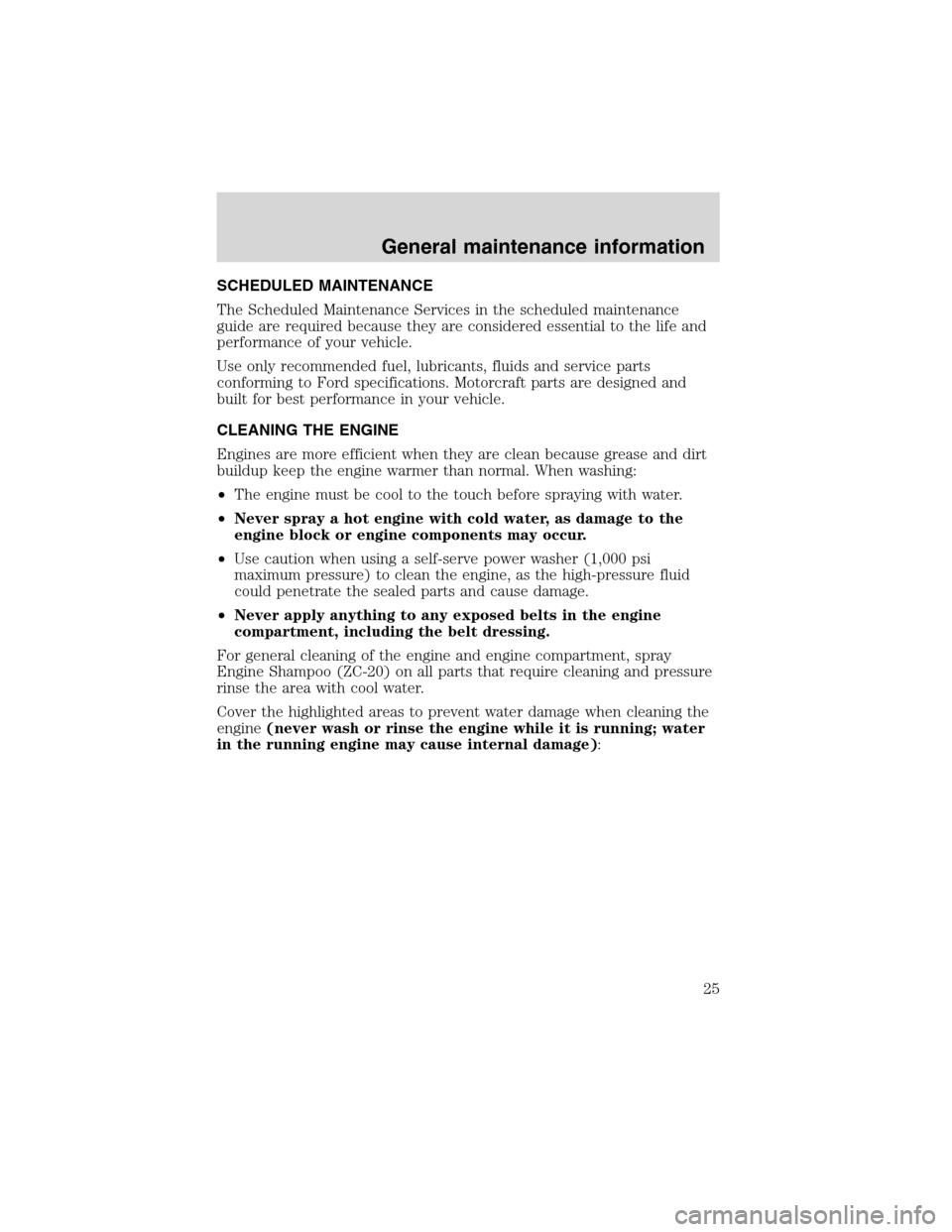
SCHEDULED MAINTENANCE
The Scheduled Maintenance Services in the scheduled maintenance
guide are required because they are considered essential to the life and
performance of your vehicle.
Use only recommended fuel, lubricants, fluids and service parts
conforming to Ford specifications. Motorcraft parts are designed and
built for best performance in your vehicle.
CLEANING THE ENGINE
Engines are more efficient when they are clean because grease and dirt
buildup keep the engine warmer than normal. When washing:
•The engine must be cool to the touch before spraying with water.
•Never spray a hot engine with cold water, as damage to the
engine block or engine components may occur.
•Use caution when using a self-serve power washer (1,000 psi
maximum pressure) to clean the engine, as the high-pressure fluid
could penetrate the sealed parts and cause damage.
•Never apply anything to any exposed belts in the engine
compartment, including the belt dressing.
For general cleaning of the engine and engine compartment, spray
Engine Shampoo (ZC-20) on all parts that require cleaning and pressure
rinse the area with cool water.
Cover the highlighted areas to prevent water damage when cleaning the
engine(never wash or rinse the engine while it is running; water
in the running engine may cause internal damage):
General maintenance information
25
Page 26 of 56
•E-Series
•F-250/350/450/550 & Excursion
FUEL REQUIREMENTS
The engine is designed to use low sulfur number 1–Dor2–D Diesel fuel
only. At temperatures below -7°C (20°F), number 1–D or winter blend
number 2–D fuel is recommended. (SeeCold Weather Operationin the
Startingchapter.)
General maintenance information
26
Page 27 of 56
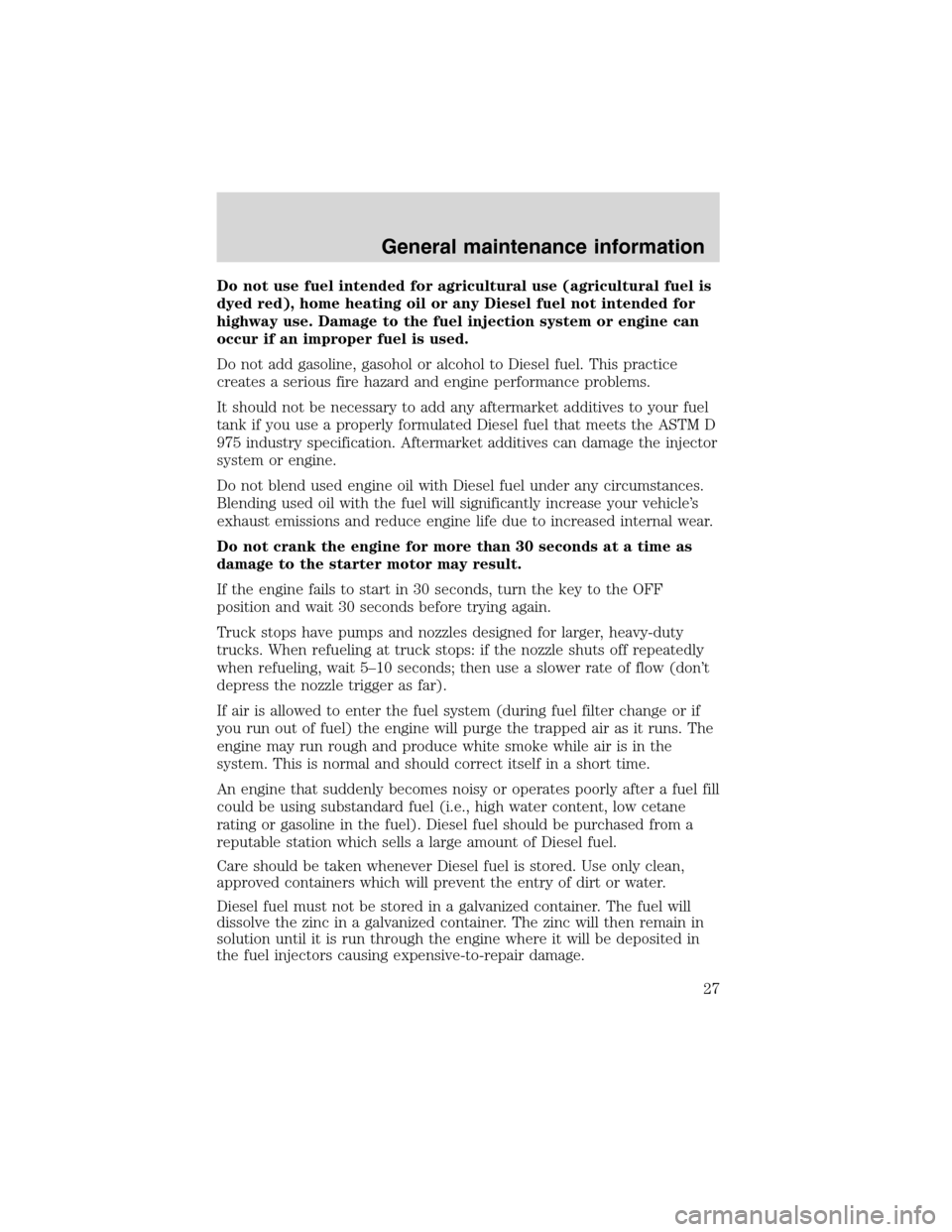
Do not use fuel intended for agricultural use (agricultural fuel is
dyed red), home heating oil or any Diesel fuel not intended for
highway use. Damage to the fuel injection system or engine can
occur if an improper fuel is used.
Do not add gasoline, gasohol or alcohol to Diesel fuel. This practice
creates a serious fire hazard and engine performance problems.
It should not be necessary to add any aftermarket additives to your fuel
tank if you use a properly formulated Diesel fuel that meets the ASTM D
975 industry specification. Aftermarket additives can damage the injector
system or engine.
Do not blend used engine oil with Diesel fuel under any circumstances.
Blending used oil with the fuel will significantly increase your vehicle’s
exhaust emissions and reduce engine life due to increased internal wear.
Do not crank the engine for more than 30 seconds at a time as
damage to the starter motor may result.
If the engine fails to start in 30 seconds, turn the key to the OFF
position and wait 30 seconds before trying again.
Truck stops have pumps and nozzles designed for larger, heavy-duty
trucks. When refueling at truck stops: if the nozzle shuts off repeatedly
when refueling, wait 5–10 seconds; then use a slower rate of flow (don’t
depress the nozzle trigger as far).
If air is allowed to enter the fuel system (during fuel filter change or if
you run out of fuel) the engine will purge the trapped air as it runs. The
engine may run rough and produce white smoke while air is in the
system. This is normal and should correct itself in a short time.
An engine that suddenly becomes noisy or operates poorly after a fuel fill
could be using substandard fuel (i.e., high water content, low cetane
rating or gasoline in the fuel). Diesel fuel should be purchased from a
reputable station which sells a large amount of Diesel fuel.
Care should be taken whenever Diesel fuel is stored. Use only clean,
approved containers which will prevent the entry of dirt or water.
Diesel fuel must not be stored in a galvanized container. The fuel will
dissolve the zinc in a galvanized container. The zinc will then remain in
solution until it is run through the engine where it will be deposited in
the fuel injectors causing expensive-to-repair damage.
General maintenance information
27
Page 28 of 56
CHANGING FUEL FILTER
Removal—F-250/350/450/550 and Excursion
1. Remove the engine appearance
cover.
2. Remove the fuel filter cap by
turning counterclockwise.
3. Remove and discard old fuel filter
element and fuel filter o-ring.
4. Carefully clean the mating
surfaces.
Removal — E-Series
1. Remove the engine appearance cover.
2. Disconnect the battery ground cable, then all electrical connectors,
vacuum tubes and fasteners as necessary for removal.
3. Release the four retaining clamps on the air cleaner assembly, then lift
the air cleaner cover and remove the air cleaner(s).
4. Loosen the clamp on the air inlet tube, then disconnect the air inlet
tube from the resonator.
5. Remove the three bolts on the turbocharger heat shield, then the
turbocharger heat shield.
6. Remove the bolt and resonator from the vehicle.
General maintenance information
28
Page 29 of 56
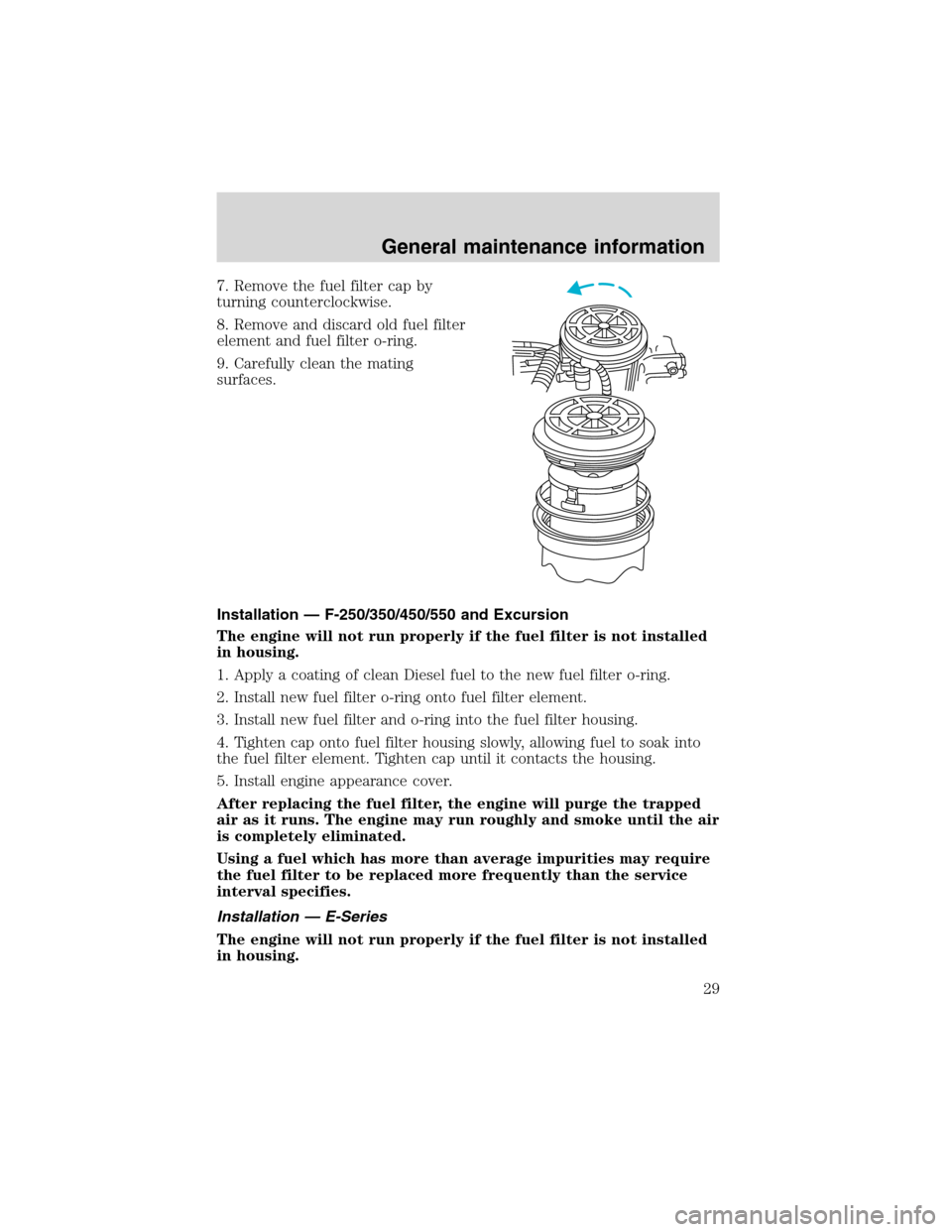
7. Remove the fuel filter cap by
turning counterclockwise.
8. Remove and discard old fuel filter
element and fuel filter o-ring.
9. Carefully clean the mating
surfaces.
Installation—F-250/350/450/550 and Excursion
The engine will not run properly if the fuel filter is not installed
in housing.
1. Apply a coating of clean Diesel fuel to the new fuel filter o-ring.
2. Install new fuel filter o-ring onto fuel filter element.
3. Install new fuel filter and o-ring into the fuel filter housing.
4. Tighten cap onto fuel filter housing slowly, allowing fuel to soak into
the fuel filter element. Tighten cap until it contacts the housing.
5. Install engine appearance cover.
After replacing the fuel filter, the engine will purge the trapped
air as it runs. The engine may run roughly and smoke until the air
is completely eliminated.
Using a fuel which has more than average impurities may require
the fuel filter to be replaced more frequently than the service
interval specifies.
Installation—E-Series
The engine will not run properly if the fuel filter is not installed
in housing.
General maintenance information
29
Page 30 of 56
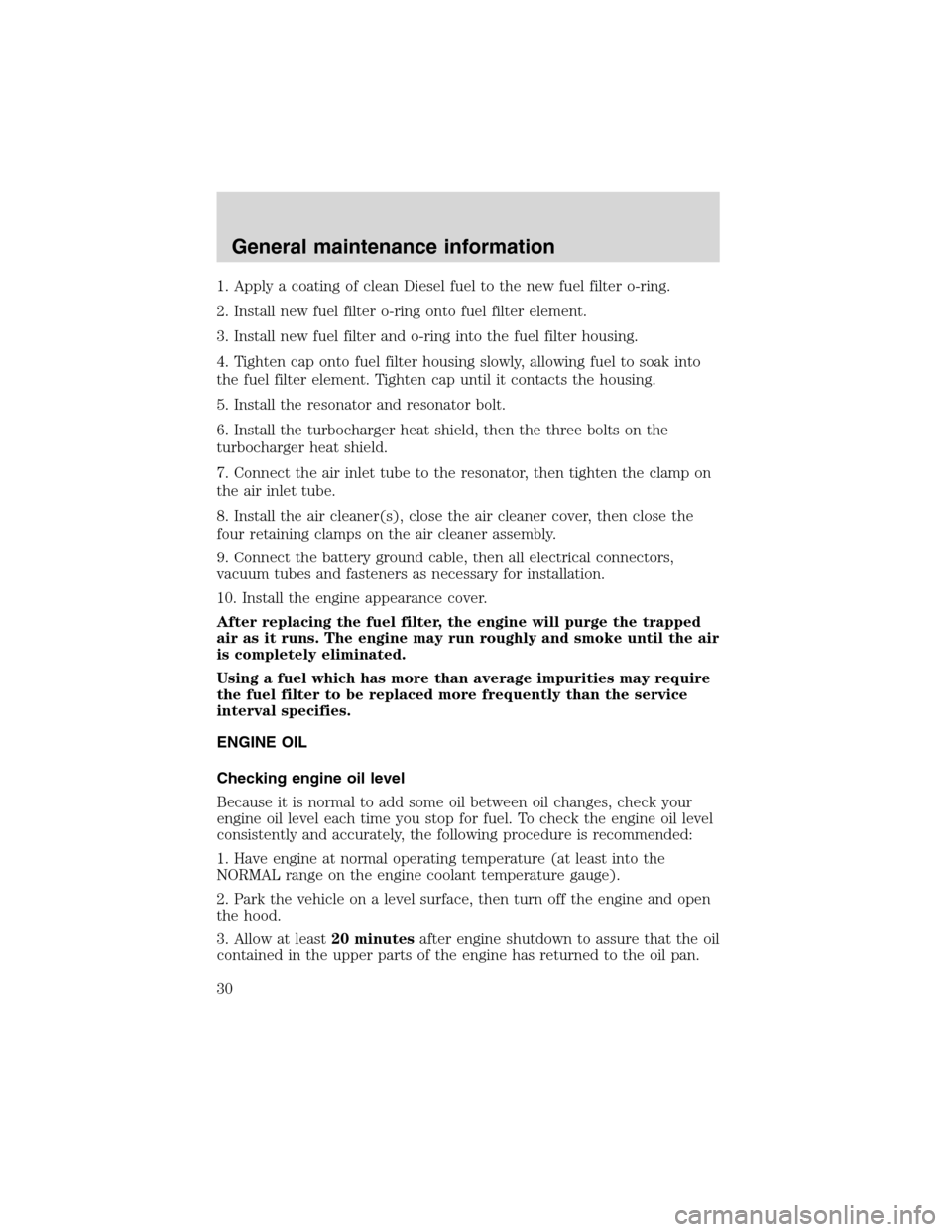
1. Apply a coating of clean Diesel fuel to the new fuel filter o-ring.
2. Install new fuel filter o-ring onto fuel filter element.
3. Install new fuel filter and o-ring into the fuel filter housing.
4. Tighten cap onto fuel filter housing slowly, allowing fuel to soak into
the fuel filter element. Tighten cap until it contacts the housing.
5. Install the resonator and resonator bolt.
6. Install the turbocharger heat shield, then the three bolts on the
turbocharger heat shield.
7. Connect the air inlet tube to the resonator, then tighten the clamp on
the air inlet tube.
8. Install the air cleaner(s), close the air cleaner cover, then close the
four retaining clamps on the air cleaner assembly.
9. Connect the battery ground cable, then all electrical connectors,
vacuum tubes and fasteners as necessary for installation.
10. Install the engine appearance cover.
After replacing the fuel filter, the engine will purge the trapped
air as it runs. The engine may run roughly and smoke until the air
is completely eliminated.
Using a fuel which has more than average impurities may require
the fuel filter to be replaced more frequently than the service
interval specifies.
ENGINE OIL
Checking engine oil level
Because it is normal to add some oil between oil changes, check your
engine oil level each time you stop for fuel. To check the engine oil level
consistently and accurately, the following procedure is recommended:
1. Have engine at normal operating temperature (at least into the
NORMAL range on the engine coolant temperature gauge).
2. Park the vehicle on a level surface, then turn off the engine and open
the hood.
3. Allow at least20 minutesafter engine shutdown to assure that the oil
contained in the upper parts of the engine has returned to the oil pan.
General maintenance information
30
Page 31 of 56
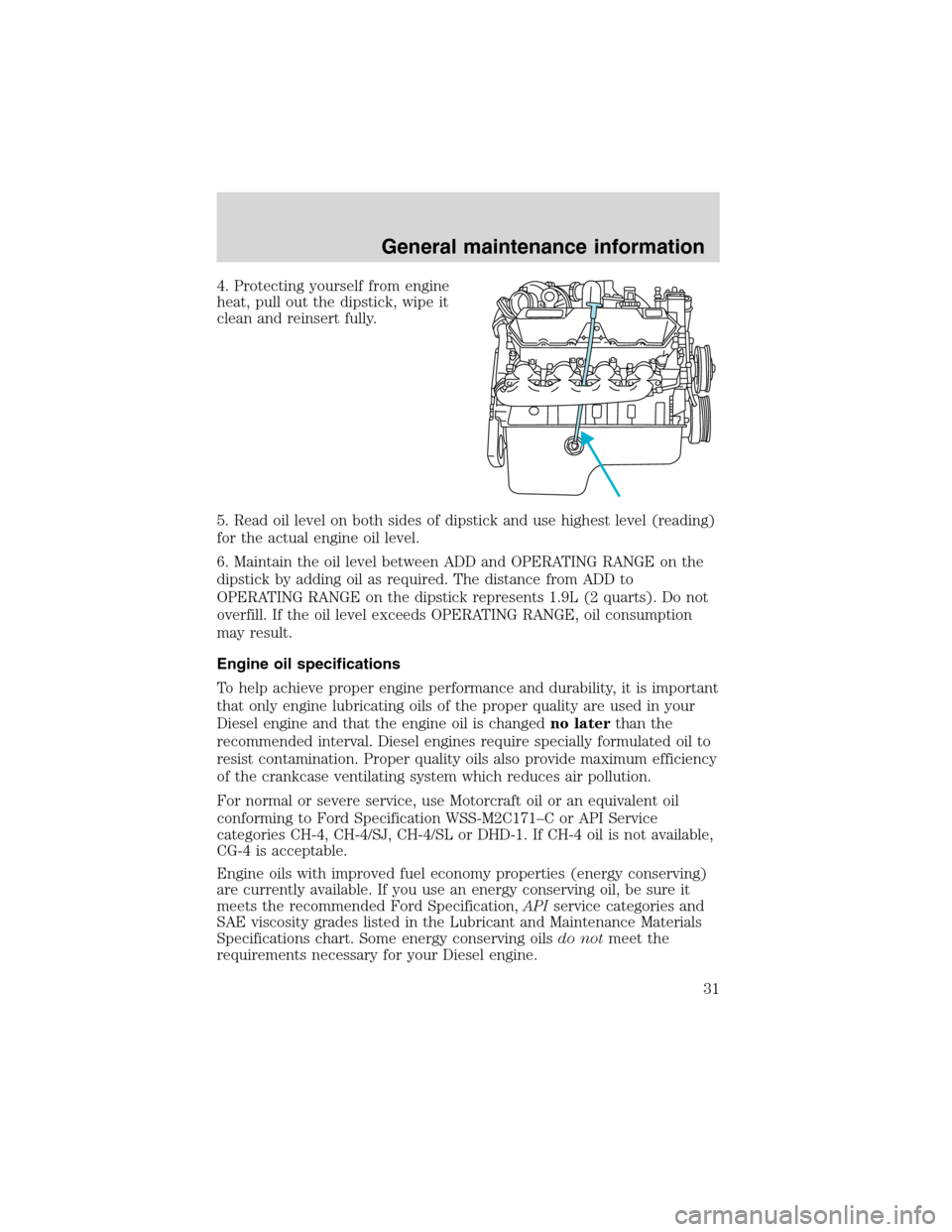
4. Protecting yourself from engine
heat, pull out the dipstick, wipe it
clean and reinsert fully.
5. Read oil level on both sides of dipstick and use highest level (reading)
for the actual engine oil level.
6. Maintain the oil level between ADD and OPERATING RANGE on the
dipstick by adding oil as required. The distance from ADD to
OPERATING RANGE on the dipstick represents 1.9L (2 quarts). Do not
overfill. If the oil level exceeds OPERATING RANGE, oil consumption
may result.
Engine oil specifications
To help achieve proper engine performance and durability, it is important
that only engine lubricating oils of the proper quality are used in your
Diesel engine and that the engine oil is changedno laterthan the
recommended interval. Diesel engines require specially formulated oil to
resist contamination. Proper quality oils also provide maximum efficiency
of the crankcase ventilating system which reduces air pollution.
For normal or severe service, use Motorcraft oil or an equivalent oil
conforming to Ford Specification WSS-M2C171–C or API Service
categories CH-4, CH-4/SJ, CH-4/SL or DHD-1. If CH-4 oil is not available,
CG-4 is acceptable.
Engine oils with improved fuel economy properties (energy conserving)
are currently available. If you use an energy conserving oil, be sure it
meets the recommended Ford Specification,APIservice categories and
SAE viscosity grades listed in the Lubricant and Maintenance Materials
Specifications chart. Some energy conserving oilsdo notmeet the
requirements necessary for your Diesel engine.
General maintenance information
31
Page 32 of 56
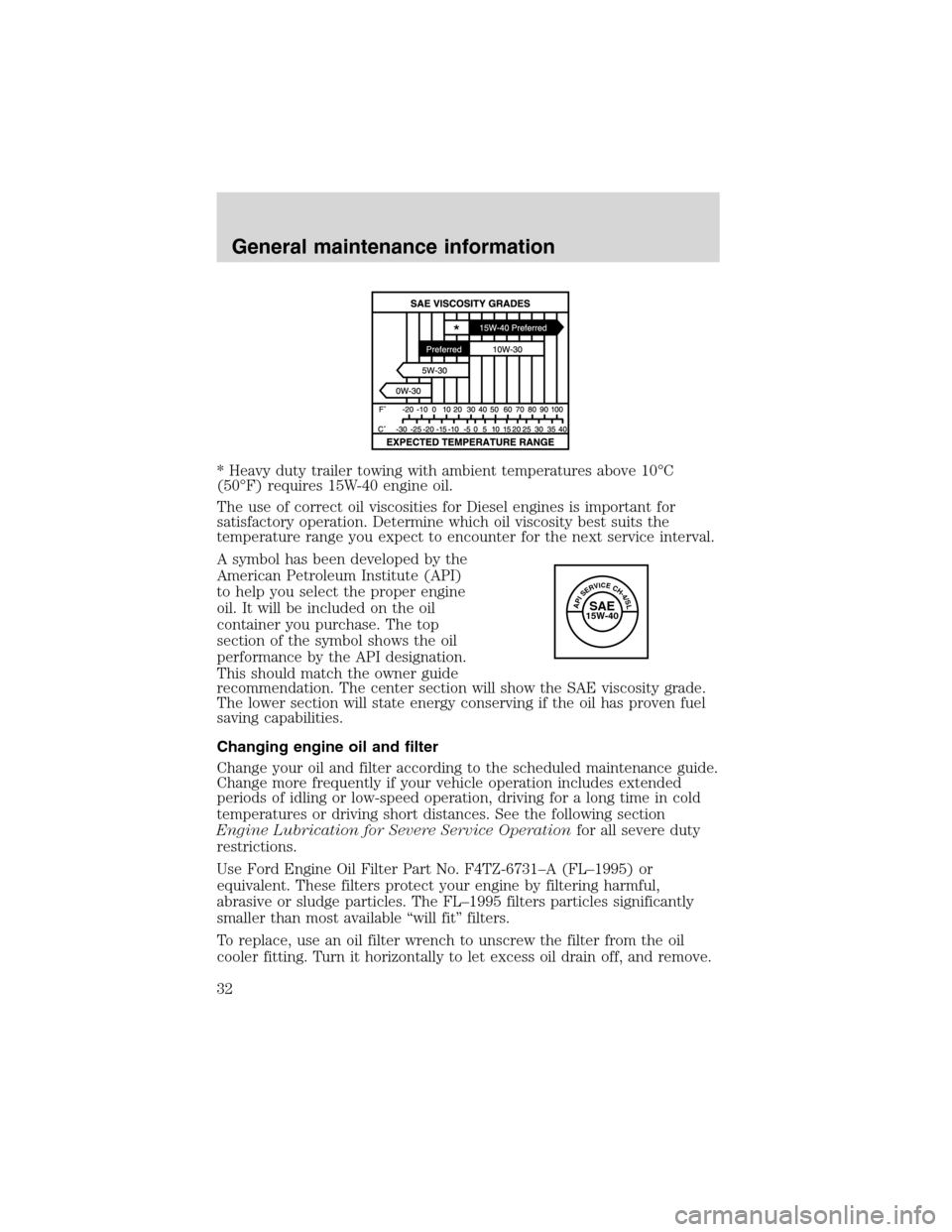
* Heavy duty trailer towing with ambient temperatures above 10°C
(50°F) requires 15W-40 engine oil.
The use of correct oil viscosities for Diesel engines is important for
satisfactory operation. Determine which oil viscosity best suits the
temperature range you expect to encounter for the next service interval.
A symbol has been developed by the
American Petroleum Institute (API)
to help you select the proper engine
oil. It will be included on the oil
container you purchase. The top
section of the symbol shows the oil
performance by the API designation.
This should match the owner guide
recommendation. The center section will show the SAE viscosity grade.
The lower section will state energy conserving if the oil has proven fuel
saving capabilities.
Changing engine oil and filter
Change your oil and filter according to the scheduled maintenance guide.
Change more frequently if your vehicle operation includes extended
periods of idling or low-speed operation, driving for a long time in cold
temperatures or driving short distances. See the following section
Engine Lubrication for Severe Service Operationfor all severe duty
restrictions.
Use Ford Engine Oil Filter Part No. F4TZ-6731–A (FL–1995) or
equivalent. These filters protect your engine by filtering harmful,
abrasive or sludge particles. The FL–1995 filters particles significantly
smaller than most available“will fit”filters.
To replace, use an oil filter wrench to unscrew the filter from the oil
cooler fitting. Turn it horizontally to let excess oil drain off, and remove.
APISERVICECH-4/SLSAE15W-40
General maintenance information
32